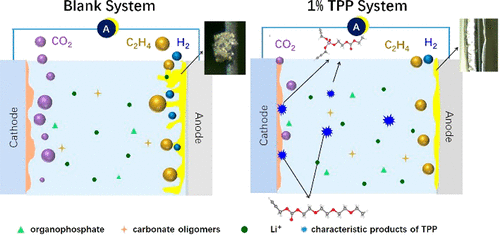当前位置:
X-MOL 学术
›
ACS Appl. Mater. Interfaces
›
论文详情
Our official English website, www.x-mol.net, welcomes your
feedback! (Note: you will need to create a separate account there.)
Mechanism Study of Unsaturated Tripropargyl Phosphate as an Efficient Electrolyte Additive Forming Multifunctional Interphases in Lithium Ion and Lithium Metal Batteries.
ACS Applied Materials & Interfaces ( IF 8.3 ) Pub Date : 2020-02-10 , DOI: 10.1021/acsami.9b21605 Yunxian Qian 1, 2, 3 , Yuanyuan Kang 1, 2, 3 , Shiguang Hu 1, 2, 3 , Qiao Shi 2 , Qun Chen 2 , Xiwu Tang 2 , Yinglin Xiao 1 , Huajun Zhao 1 , Guangfu Luo 1 , Kang Xu 4 , Yonghong Deng 1
ACS Applied Materials & Interfaces ( IF 8.3 ) Pub Date : 2020-02-10 , DOI: 10.1021/acsami.9b21605 Yunxian Qian 1, 2, 3 , Yuanyuan Kang 1, 2, 3 , Shiguang Hu 1, 2, 3 , Qiao Shi 2 , Qun Chen 2 , Xiwu Tang 2 , Yinglin Xiao 1 , Huajun Zhao 1 , Guangfu Luo 1 , Kang Xu 4 , Yonghong Deng 1
Affiliation

|
Electrolytes in modern Li-ion batteries (LIBs) rely on additives of various structures to generate key interphasial chemistries needed for desired performances, although how these additives operate in battery environments remains little understood. Meanwhile, these traditional additives face increasing challenges from emerging battery chemistries, especially those based on high nickel cathode (Ni ≥ 50%) or the metallic lithium anode. In this work, we report a new additive structure with the highest unsaturation degree known so far, along with in-depth understanding of its breakdown mechanism on those aggressive electrode surfaces. Tripropargyl phosphate (TPP) containing three carbon-carbon triple bonds was found to form dense and protective interphases on both NMC532 cathode as well as graphitic and metallic lithium anodes, leading to significant improvements in performances of both LIBs and lithium metal batteries (LMBs). Comprehensive characterizations together with calculations reveal how the unsaturation functionalities of TPP interact with these electrode chemistries and establish interphases that inhibit gas generation, suppress lithium dendrite growth, prevent transition metal ion dissolution and deposition on the anode surface. The correlation established among the additive structure, interphasial chemistries and cell performance will doubtlessly guide us in designing the electrolytes with atomistic precision for future battery chemistries.
中文翻译:

不饱和磷酸三炔丙基酯作为高效电解质添加剂在锂离子和锂金属电池中形成多功能相的机理研究。
现代锂离子电池(LIB)中的电解质依赖于各种结构的添加剂来生成所需性能所需的关键相间化学物质,尽管这些添加剂在电池环境中的运行方式仍知之甚少。同时,这些传统的添加剂面临着新兴电池化学的日益严峻的挑战,尤其是那些基于高镍阴极(Ni≥50%)或金属锂阳极的化学添加剂。在这项工作中,我们报告了迄今为止已知的具有最高不饱和度的新添加剂结构,并深入了解了其在那些腐蚀性电极表面上的击穿机理。发现含有三个碳-碳三键的磷酸三炔丙酯(TPP)在NMC532阴极以及石墨和金属锂阳极上均形成致密和保护性的中间相,从而大大改善了锂电池和锂金属电池(LMB)的性能。综合表征和计算结果表明,TPP的不饱和官能度如何与这些电极化学相互作用并建立抑制气体生成,抑制锂枝晶生长,防止过渡金属离子溶解和沉积在阳极表面的中间相。添加剂结构,相间化学性质和电池性能之间建立的相关性无疑将指导我们为未来的电池化学性质设计具有原子精度的电解质。综合表征和计算结果表明,TPP的不饱和官能度如何与这些电极化学相互作用并建立抑制气体生成,抑制锂枝晶生长,防止过渡金属离子溶解和沉积在阳极表面的中间相。添加剂结构,相间化学性质和电池性能之间建立的相关性无疑将指导我们为未来的电池化学性质设计原子精确的电解质。综合表征和计算结果表明,TPP的不饱和官能度如何与这些电极化学物质相互作用,并建立抑制气体生成,抑制锂枝晶生长,防止过渡金属离子溶解和沉积在阳极表面的中间相。添加剂结构,相间化学性质和电池性能之间建立的相关性无疑将指导我们为未来的电池化学性质设计具有原子精度的电解质。
更新日期:2020-02-21
中文翻译:

不饱和磷酸三炔丙基酯作为高效电解质添加剂在锂离子和锂金属电池中形成多功能相的机理研究。
现代锂离子电池(LIB)中的电解质依赖于各种结构的添加剂来生成所需性能所需的关键相间化学物质,尽管这些添加剂在电池环境中的运行方式仍知之甚少。同时,这些传统的添加剂面临着新兴电池化学的日益严峻的挑战,尤其是那些基于高镍阴极(Ni≥50%)或金属锂阳极的化学添加剂。在这项工作中,我们报告了迄今为止已知的具有最高不饱和度的新添加剂结构,并深入了解了其在那些腐蚀性电极表面上的击穿机理。发现含有三个碳-碳三键的磷酸三炔丙酯(TPP)在NMC532阴极以及石墨和金属锂阳极上均形成致密和保护性的中间相,从而大大改善了锂电池和锂金属电池(LMB)的性能。综合表征和计算结果表明,TPP的不饱和官能度如何与这些电极化学相互作用并建立抑制气体生成,抑制锂枝晶生长,防止过渡金属离子溶解和沉积在阳极表面的中间相。添加剂结构,相间化学性质和电池性能之间建立的相关性无疑将指导我们为未来的电池化学性质设计具有原子精度的电解质。综合表征和计算结果表明,TPP的不饱和官能度如何与这些电极化学相互作用并建立抑制气体生成,抑制锂枝晶生长,防止过渡金属离子溶解和沉积在阳极表面的中间相。添加剂结构,相间化学性质和电池性能之间建立的相关性无疑将指导我们为未来的电池化学性质设计原子精确的电解质。综合表征和计算结果表明,TPP的不饱和官能度如何与这些电极化学物质相互作用,并建立抑制气体生成,抑制锂枝晶生长,防止过渡金属离子溶解和沉积在阳极表面的中间相。添加剂结构,相间化学性质和电池性能之间建立的相关性无疑将指导我们为未来的电池化学性质设计具有原子精度的电解质。






























 京公网安备 11010802027423号
京公网安备 11010802027423号